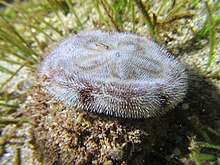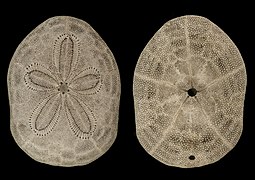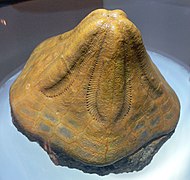Clypeaster
Appearance
| Clypeaster Temporal range:
| |
|---|---|

| |
| Live Clypeaster reticulatus | |
| Scientific classification | |
| Domain: | Eukaryota |
| Kingdom: | Animalia |
| Phylum: | Echinodermata |
| Class: | Echinoidea |
| Order: | Clypeasteroida |
| Family: | Clypeasteridae |
| Genus: | Clypeaster Lamarck , 1801
|
Clypeaster, common name "cake urchins" or "sea biscuits", is a genus of echinoderms belonging to the family Clypeasteridae.
Etymology
The genus name Clypeaster is derived from the Latin “clypeus” (meaning round shield) and “aster” (meaning star), with reference to the shape of these organisms.
List of species
- Clypeaster aloysioi (Brito, 1959)
- Clypeaster amplificatus Koehler, 1922
- Clypeaster annandalei Koehler, 1922
- Clypeaster australasiae (Gray, 1851)
- Clypeaster chesheri Serafy, 1970
- Clypeaster cyclopilus H.L. Clark, 1941
- Clypeaster durandi (Cherbonnier, 1959b)
- Clypeaster elongatus H.L. Clark, 1948
- Clypeaster euclastus H.L. Clark, 1941
- Clypeaster europacificus H.L. Clark, 1914
- Clypeaster eurychorius H.L. Clark, 1924
- Clypeaster euryptealus H.L. Clark, 1925
- Clypeaster fervens Koehler, 1922
- Clypeaster humilis (Leske, 1778)
- Clypeaster isolatus Serafy, 1971
- Clypeaster japonicus Döderlein, 1885
- Clypeaster kieri Pawson & Phelan, 1979
- Clypeaster lamprus H.L. Clark, 1914
- Clypeaster latissimus (Lamarck, 1816)
- Clypeaster leptostracon A. Agassiz & H.L. Clark, 1907
- Clypeaster luetkeni Mortensen, 1948
- Clypeaster lytopetalus A. Agassiz & H.L. Clark, 1907
- Clypeaster microstomus Lambert, 1912 †
- Clypeaster miniaceus H.L. Clark, 1925
- Clypeaster minihagali Deraniyagala, 1956 †
- Clypeaster nummus Mortensen, 1948
- Clypeaster ochrus H.L. Clark, 1914
- Clypeaster ohshimensis Ikeda, 1935
- Clypeaster oliveirai Krau, 1952
- Clypeaster pallidus H.L. Clark, 1914
- Clypeaster pateriformis Mortensen, 1948
- Clypeaster prostratus (Ravenel, 1845)
- Clypeaster rangianus Desmoulins, 1835
- Clypeaster rarispinus de Meijere, 1903
- Clypeaster ravenelii (A. Agassiz, 1869)
- Clypeaster reticulatus (Linnaeus, 1758)
- Clypeaster rosaceus (Linnaeus, 1758)
- Clypeaster rotundus (A. Agassiz, 1863)
- Clypeaster speciosus Verrill, 1870
- Clypeaster subdepressus (Gray, 1825)
- Clypeaster telurus H.L. Clark, 1914
- Clypeaster tumidus (Tension-Woods, 1878)
- Clypeaster virescens Döderlein, 1885
Gallery
-
Clypeaster reticulatus
-
Fossil of Clypeaster bowersi the San Diego Natural History Museum, California
-
Fossil of Clypeaster insignis at the San Diego County Fair, California
-
Fossil of Clypeaster portentosus at the Museo Arqueológico Municipal de Cartagena
References
- Clypeaster Lamarck, 1801[permanent dead link]
- Animal Diversity
- National History Museum
- Sepkoski, Jack Sepkoski's Online Genus Database
- Paleobiology Database







